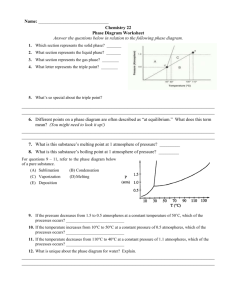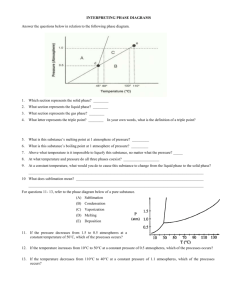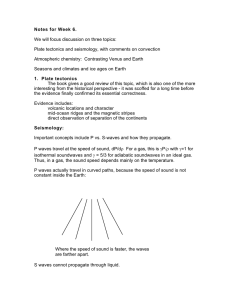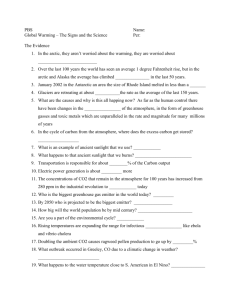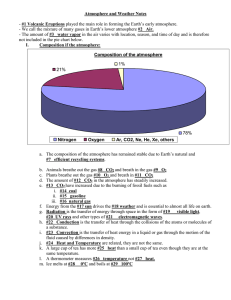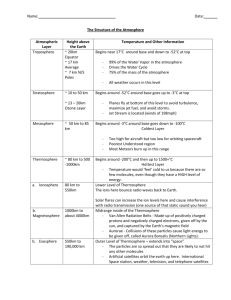THERMAL ESCAPE FROM SUPER EARTH Please share
advertisement
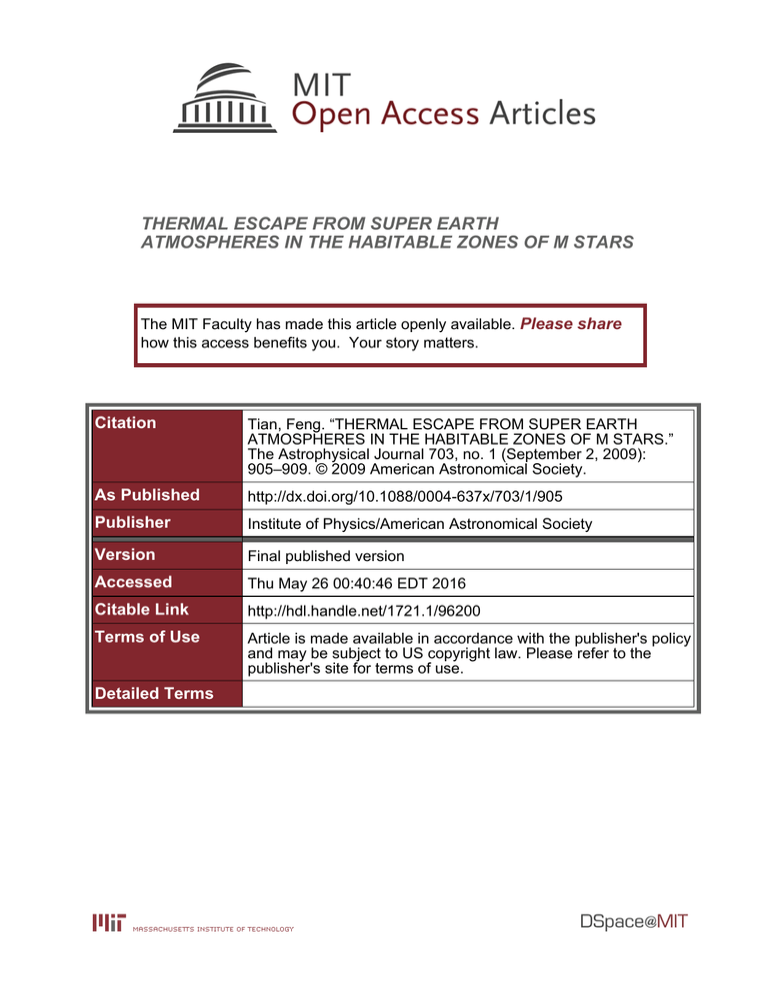
THERMAL ESCAPE FROM SUPER EARTH ATMOSPHERES IN THE HABITABLE ZONES OF M STARS The MIT Faculty has made this article openly available. Please share how this access benefits you. Your story matters. Citation Tian, Feng. “THERMAL ESCAPE FROM SUPER EARTH ATMOSPHERES IN THE HABITABLE ZONES OF M STARS.” The Astrophysical Journal 703, no. 1 (September 2, 2009): 905–909. © 2009 American Astronomical Society. As Published http://dx.doi.org/10.1088/0004-637x/703/1/905 Publisher Institute of Physics/American Astronomical Society Version Final published version Accessed Thu May 26 00:40:46 EDT 2016 Citable Link http://hdl.handle.net/1721.1/96200 Terms of Use Article is made available in accordance with the publisher's policy and may be subject to US copyright law. Please refer to the publisher's site for terms of use. Detailed Terms The Astrophysical Journal, 703:905–909, 2009 September 20 C 2009. doi:10.1088/0004-637X/703/1/905 The American Astronomical Society. All rights reserved. Printed in the U.S.A. THERMAL ESCAPE FROM SUPER EARTH ATMOSPHERES IN THE HABITABLE ZONES OF M STARS Feng Tian1 Department of Earth, Atmospheric, and Planetary Sciences, Massachusetts Institute of Technology, Cambridge 02139, MA, USA Received 2008 November 10; accepted 2009 August 4; published 2009 September 2 ABSTRACT A fundamental question for exoplanet habitability is the long-term stability of the planet’s atmosphere. We numerically solve a one-dimensional multi-component hydrodynamic thermosphere/ionosphere model to examine the thermal and chemical responses of the primary CO2 atmospheres of heavy super Earths (6–10 Earth masses) in the habitable zones of typical low-mass M stars to the enhanced soft X-ray and ultraviolet (XUV) fluxes associated with the prolonged high-activity levels of M stars. The results show that such atmospheres are stable against thermal escape, even for M stars XUV enhancements as large as 1000 compared to the present Earth. It is possible that the CO2 dominant atmospheres of super Earths in the habitable zones of M stars could potentially contain modest amount of free oxygen as a result of more efficient atmosphere escape of carbon than oxygen instead of photosynthesis. Key words: planetary systems – planets and satellites: general Another estimate gives 2 × 1028 erg s−1 based on the observations of AE-E satellite (50–1050 Å) between 1976 and 1979 (Hinteregger 1981). The location of the HZ is controlled by the host star’s bolometric luminosity LBol . As a first approximation the stellar, LBol can be seen as the same in the HZ regardless of the star mass, and thus a larger LX /LBol ratio of the star is equivalent to a stronger soft X-ray and EUV (XUV) flux in the HZ. The LX /LBol ratio is ∼10−6 for the present Sun, while ranges from 10−5 to 10−2 for M stars, with a typical value of no more than 10−3 (Scalo et al. 2007). Thus, the typical XUV fluxes in the HZ of M stars are 10–1000 times the present Earth level (PEL). The Earth was under XUV flux 100× PEL during the first 100 Myr after its formation (the solar ratio in the order of 10−4 ), and the Earth XUV level dropped to about 10× PEL when the Sun was ∼0.5 billion years ago (Ayres 1997, Ribas et al. 2005). In contrast, early-type M stars can remain active for 0.5–1 Gyr, while the late-type M stars can remain active for as long as 8 billion years (West et al. 2008). Whether or not and how much a terrestrial planet’s atmosphere could be maintained under the extreme XUV radiation from an M star during its active phase can be a critical constraint on the habitability. In this work, we applied a recently developed planetary upper atmosphere model (Tian et al. 2008a, 2008b, 2009) to investigate the responses of CO2 -dominant atmospheres of heavy super Earths (mass range 6–10 Earth masses) under extreme XUV radiation in the HZs of active M stars. Thermal escape from such atmospheres and the impact on atmosphere stability are investigated. CO2 atmospheres are the focus of this paper because such atmospheres provide a conservative upper limit to atmospheric loss estimates—CO2 has the effective IR-cooling mechanism (the 15 μm band emission and other band emissions, see the discussion), which slows down the warm-up and the expansion of the upper atmosphere, and thus results in the slowest atmosphere escape. If a CO2 -dominated atmosphere cannot be maintained in certain environments, atmospheres dominated by N2 , O2 , or H2 would be lost on much shorter timescales. For the same reason, we focus on heavy super Earth in this work. The simulations show that the upper atmospheres of heavy super Earths under extreme stellar XUV radiation expand to great distances (several planetary radii), and thus fast thermal 1. INTRODUCTION Super Earths are a recently discovered class of exoplanets with masses greater than that of the Earth and smaller than 10 Earth masses. Because these planets have much lower masses than giant planets, they likely consist substantially of rocky material, making them likely the first terrestrial-like planets discovered outside of our solar system. Moreover, the search for super Earths in the habitable zones (HZ) of small stars is on, with discoveries anticipated in the next few years. dM stars (hereafter referred to M stars in this paper), with masses in the range of 0.08 and 0.6 solar mass (Scalo et al. 2007), are of special interest to observers because of the large numbers and the large planet to star mass ratios. Central to the argument for planet habitability (of surface life) is whether or not a planet can retain its atmosphere, because the atmosphere can regulate surface temperature and protect life on the surface from harmful solar or cosmic rays. All atmospheric escape mechanisms depend on the properties (temperature, density, composition, etc.) of planetary upper atmospheres. The main heating contributors for the thermosphere of solar system planets are the soft X-ray photons (5–100 Å) and the EUV photons (100–1000 Å) from the Sun, at which wavelength the absorption cross sections of major atmospheric gases are significantly larger than at shorter or longer wavelengths. Our knowledge of the EUV radiation from M stars is limited at least partially because of the strong absorption of EUV photons by interstellar gas (HI) and dust (Slavin 2004, Barstow & Holberg 2003). In comparison, stellar soft X-ray radiation is more readily observed (Schimitt & Liefke 2004). Because soft X-ray and EUV emissions are produced by the same physical mechanism (Scalo et al. 2007, Cravens 1997), it is reasonable to assume that a star’s EUV luminosity (LEUV ) scales as its soft X-ray luminosity (LX ). The present day solar LX (5–124 Å) inferred from observations is between 6 × 1026 and 8 × 1027 erg s−1 in a typical solar cycle (Judge et al. 2003). Solar short wavelength radiation (50–1200 Å) observed by nine Russian spacecrafts between 1978 and 1997 is between 4 × 1027 and 1.4 × 1028 erg s−1 (Kazachevskaya et al. 1998). 1 Now at Laboratory for Atmospheric and Space Physics, University of Colorado, Boulder, CO 80309, USA. 905 906 TIAN Vol. 703 escape of major atmosphere species does occur. However, the strong gravity of the planet exposes a strict limit on the level of the external energy input in order to support the outflow of the upper atmosphere. The energy constraint causes most heavy super Earths in the HZs of typical M stars to be able to maintain dense CO2 atmospheres against thermal escape. 2. MODEL The one-dimensional, multi-component, hydrodynamic, thermosphere/ionosphere model used in this work solves the time-independent continuity and momentum equations to obtain the velocity and density fields (Tian et al. 2008a): 1 dT 1 dm g 1 dρ u du =− + − 2− 2 ρ dr T dr m dr u0 u0 dr 1 du 1 dT u2 1 dm g 2 1− 2 = − + − . u dr T dr m dr u20 r u0 (1) (2) Here ρ is the gas density, r is the distance from the planet center, T is the temperature, u is the bulk motion velocity of the steady-state radial outflow, or wind, of the background gas, m is the mean molecular mass, gravity g = GM/r 2 , with G being the universal gravitational constant and M being the mass of the planet, and u20 = kT /m, with k being the Boltzmann constant. Information of the temperature field is required in order to solve Equations (1) and (2). In the steady state, the energy equation can be reduced to the following equation if the variations of the mean molecular mass with time and space are ignored (Tian et al. 2008a): 1 ∂T 1 ∂ 1 ∂T 1 ∂p 2 ∂T = κr + q − u − . γ ∂t ρCp r 2 ∂r ∂r ∂r ρCp ∂r (3) Here p is the pressure, κ is the thermal conductivity, γ is the adiabatic constant, and q is the volume heating rate. This energy equation is similar to the energy balance equation in Yelle (2004) and can be further simplified to Equation (3) in Kasting & Pollack (1983). The entire system approaches a steady-state outflow, and the time-dependent version of the energy equation is used in order to approach this steady state from some adopted initial conditions. The last term on the righthand side is the adiabatic cooling term, which is proportional to the bulk motion velocity u and is critical in the energy budget for planetary upper atmospheres’ under strong XUV radiation (Tian et al. 2008a, 2008b, 2009). At the top boundary, which is set at the exobase, u = i ui fi , where ui and fi are the effusion velocity and the volume mixing ratio of gas species i, respectively. In this work, we consider only the thermal escape; thus, the effusion velocity of species i is evaluated using the Jeans escape formula adjusted by the bulk motion velocity, which is a standard method to estimate the thermal escape. To obtain the mixing ratios, diffusion equations for gas species under the minor constituent approximation are solved (see Tian et al. 2008a for the derivations and details of the diffusion equations). The solar spectrum at 1 AU under the solar mean condition (Figure 1 in Tian et al. 2008a) is used as the base in this model. Although the planetary upper atmospheres are sensitive only to XUV photons, for completeness the radiation spectrum extends from 0.5 to 1750 Å. The spectra are from the EUVAC model, a solar XUV FLux model for aeronomic calculations with 22 bins at wavelengths <1050 Å (Solomon & Qian 2005). Figure 1. Present Venus profiles of absorbed XUV energy, neutral heating from chemical reactions, and neutral heating from ambient electrons. The spectra between 1050 and 1750 Å are from Woods & Rottman (2002). For super Earths in the HZ of M stars, the solar mean spectrum is multiplied by factors 10, 100, and 1000 to obtain spectra corresponding to 10×, 100×, and 1000× PEL. Note that the small cross sections of major atmospheric gases at UV wavelengths (>1000 Å) ensure that the enhanced UV photon fluxes do NOT significantly influence the upper atmosphere calculations. The model was originally developed to investigate the response of N2 –O2 upper atmospheres to increasing levels of XUV radiation and is validated against the thermosphere/ionosphere of the present Earth (Tian et al. 2008a, 2008b). An electron transport-energy deposition model (GLOW) is coupled to the thermosphere–ionosphere model so that the ionization, dissociation, and excitation rates of major thermospheric constituents, along with the ambient electron heating rates, can be calculated, which allows us to avoid making arbitrary assumptions on the XUV heating efficiency. In order to apply the model to a CO2 -dominant atmosphere, electron impact cross sections for both CO2 and CO (Sawada et al. 1972) were added to the GLOW model. The original thermosphere–ionosphere model (Tian et al. 2008a) includes CO2 -related chemical reactions, and the chemical scheme is further expanded to include atomic carbon reactions listed in Fox & Sung (2001). A new radiative cooling channel, CO 4.7 μm band, is added to the model in addition to the original radiative cooling mechanisms (CO2 15 μm band, NO 5.3 μm band, atomic oxygen fine structure 63 μm band). This is to account for the strong dissociation of CO2 and the increasing concentration of CO under high XUV levels. The spatial resolution is chosen in order to ensure that the chemical reaction network would have accurate solutions. We do not expect the steady-state wind solution to change significantly by further increasing the spatial resolution. Because we are concerned about CO2 -dominant atmospheres, the best validation target should be the upper atmosphere of the present Venus. Here we show (Figure 1) the calculated heating profiles in the Venus’ upper atmosphere: the total absorbed XUV energy, the neutral heating from neutral–neutral and ion–neutral chemical reactions, and the neutral heating from ambient electrons. These profiles are in acceptable agreement with Figures 10 and 12 in Fox & Dalgarno (1981) and Figure 1 in Fox (1988), considering the different atmosphere profiles used in this work and the previous works. No. 1, 2009 THERMAL ESCAPE FROM SUPER EARTH ATMOSPHERES Figure 2. Temperature profiles of a 6 Earth-mass planet under different levels of XUV radiation. The numbers indicate the XUV normalized to the present day solar mean XUV energy flux at the Earth. The negative temperature gradients in 500× and 900× XUV cases are indications that the thermosphere is in the hydrodynamic regime (Tian et al. 2008a, 2008b). In general, the thermosphere is thermally decoupled from the lower atmosphere, which allows the thermal balance of the thermosphere to be modeled independently of the thermal balance of the lower atmosphere. The lower boundary of our upper atmosphere model is selected at the altitude where the total number density is ∼1012 cm−3 , which ensures that the lower atmosphere dynamic and energetic processes do not affect the simulation results significantly. The upper boundary is at the exobase level, the altitude of which is evaluated by comparing the pressure scale height with the mean free path, and adjusted at the end of each iteration. It is important to point out that the model is a subsonic hydrodynamic model in the sense that the bulk flow velocity at the top boundary cannot exceed the local sound speed. This treatment allows the smooth transition of the modeled upper atmosphere from a hydrostatic regime into a hydrodynamic regime, but also limits the model’s application to extreme XUV conditions. The development of a transonic, multi-component, hydrodynamic model for super Earths will be an important future work. All calculations assume the same mean planet density as that of the Earth and the planet radii are scaled according to the masses. 3. RESULTS The atmosphere structures (temperature and density) of a 6 Earth-mass super Earth under different XUV conditions (80, 200, 500, and 900× PEL) are shown in Figures 2 and 3. Under 80× PEL, the exobase is at 400 km altitude, and the thermosphere temperature is ∼2000 K. When the XUV level increases to 200×, the exobase moves out to 10000 km, and the thermosphere temperature reaches 27,000 K. This is the critical XUV level beyond which the thermosphere of a CO2 dominant atmosphere of a 6 Earth-mass planet enters into the hydrodynamic regime, proposed by Tian et al. (2008a, 2008b). In the hydrodynamic regime, the major gases at the exobase escape fast enough that the radial outflow of the upper thermosphere consumes so much XUV energy that the temperature drops with altitude. In the hydrodynamic regime, the more the energy enters the thermosphere, the higher the peak thermosphere temperature and the lower the exobase temperature become (Figure 2). The negative temperature gradient in the upper thermosphere is 907 Figure 3. Density profiles of a 6 Earth-mass planet under different levels of XUV radiation. Numbers indicate the XUV normalized to present day solar mean XUV energy flux at the Earth. the macroscopic signature indicating that the planetary atmosphere is well within the hydrodynamic regime. It is the hydrodynamic nature of the planetary upper atmospheres under strong XUV radiation that prevents the corresponding atmospheres from entering the blow-off regime, in which the exobase extends to infinity, which leads to even faster atmosphere escape (Tian et al. 2008a, 2008b). The thermosphere structures of super Earths 7.5 and 10 Earthmass under different XUV have similar properties to those of 6 Earth-mass super Earth. Thus we do not repeat them. Instead Figure 4 shows the variations of the exobase locations and temperatures as functions of XUV for different super Earths. It can be inferred from Figure 4 that the critical XUV levels are 400× and 1000× PEL for 7.5 and 10 Earth-mass super Earths, respectively. It is also interesting to note that at the critical XUV level, the exobase temperature is higher for a more massive planet and the exobase location is further away from the planet— both facilitate the thermal escape of major atmosphere species at the exobase. A planet with a greater mass has a stronger gravity field, and a higher temperature is required for efficient thermal escape to occur, until when adiabatic cooling effect will not become dominant. All of these features are qualitatively the same as those found in Tian et al. (2008a, 2008b) but different parameter space is occupied. Another interesting feature of a thermosphere under extreme XUV radiation is the fast dissociation of molecular species. Figure 5 shows the distribution of CO2 (as a representative of all molecular gases) under 80×, 200×, and 900× PEL for a 6 Earth-mass planet. At the same altitude, CO2 density becomes progressively smaller with increasing XUV. In contrast, Figure 3 shows that the total density at the same altitude becomes higher with increasing XUV which is the result of an increased scale height under higher thermosphere temperature (Figure 2) and an increased abundance of lighter species. It is reasonable to conclude that the radiative cooling effect of CO2 and other molecular species in the planetary upper atmosphere will become increasingly small under stronger XUV, which means that the trend of heating and expansion will be highly nonlinear. Figure 6 shows the thermal escape flux of atomic carbon as the functions of XUV. Carbon escape directly reflects the loss of CO2 , the major component of the corresponding planetary atmospheres. Present Venus has ∼100 bars of CO2 (1046 molecules or 5 × 1020 kg) in its atmosphere. Present Earth 908 Figure 4. Exobase locations and temperatures as the functions of XUV radiation normalized to the present Earth level. Planet masses are indicated by the numbers in the figure. TIAN Vol. 703 Figure 6. Carbon thermal escape fluxes as the functions of XUV radiation. The dashed curves are extrapolated linearly from the C escape fluxes under high XUV levels. The vertical dotted line marks the XUV radiation level at 1000× PEL. The horizontal dotted line marks the carbon escape flux (3 × 1011 cm−2 s−1 ) needed to deplete the entire CO2 inventory of a super Earth in 1 Gyr, assuming its initial CO2 content is similar to that of the Earth. 4. DISCUSSION Figure 5. CO2 number density profiles of a 6 Earth-mass planet under different XUV levels. CO2 density drops with altitude faster under stronger XUV due to more efficient dissociation. has ∼1.8 × 1022 mol and 0.6 × 1022 mol of CO2 in its mantle and crust respectively (Zhang & Zindler 1993; Sleep & Zahnle 2001)—a total of 1.4 × 1046 molecules. Thus, it is a reasonable estimate that the initial CO2 inventory on early Earth and Venus was 2–3 × 1046 CO2 molecules. If we assume that a planet’s total CO2 inventory is proportional to its mass scaled by the Earth value, a carbon escape flux of 2–3 × 1011 cm−2 s−1 would be required to deplete the entire CO2 inventory of a super Earth over a timescale of 1 Gyr. Such high escape fluxes are not reached in our calculations under the typical XUV levels (10−3 PEL) for habitable planets around M stars (solid curves in Figure 6). Thus, the CO2 atmospheres of super Earths in the habitable zones of typical M stars should be stable against thermal escape even during the stars’ active phase. We note, however, that linear extrapolations of available super Earth calculations under high XUV conditions (dashed lines in Figure 6) suggest that the carbon thermal escape flux from 6–10 Earth-mass super Earths could reach 1011 cm−2 s−1 level under a few thousand to 10 thousand times PEL, which is possible in the HZs of some active M stars (LX /LBol ∼ 10−2 ). Thus not all heavy super Earths in the HZ of M stars have stable CO2 atmospheres against thermal escape. There are multiple sources of uncertainties, which may influence the conclusions presented here. Super Earths could be formed with more or less CO2 per unit mass than the Earth. More realistic calculations of the upper atmosphere structure under extreme XUV conditions can be obtained by developing transonic hydrodynamic model. To include additional IR-cooling channels, such as the emissions of excited atoms/ ions, the CO2 4.3 μm band, and other hot bands, could be important to improve the energy treatment in the model. However, the significance of molecular species in cooling the super Earths’ upper atmospheres diminishes under strong EUV because these species should be destroyed more efficiently (Figure 5). Indeed sensitivity studies show that under 1000× EUV, the carbon escape flux from a 10 Earth-mass planet drops 20% when increasing the CO2 -cooling rate by a factor of 10. One of the major uncertainties is the neglect of nonthermal escape mechanisms in the atmosphere escape calculations. The calculated super Earth thermospheres expand to 5 planetary radii from the planet center (Figure 4) when exposed to 1000 × PEL. In comparison, the location of the magnetopause of an Earth-size planet around a 0.5 solar-mass star is less than 3 planet radii if the planet is tidally locked, which produces weak intrinsic magnetic field, but could be beyond 6 planet radii if the planet is not tidally locked (Khodachenko et al. 2007). Although the locations of the magnetopause of super Earths are not well known, the highly expanded atmospheres of super Earths could have been subject to stellar wind erosion. Lammer et al. (2007) showed that coronal mass ejections (CMEs) from the central star could erode several hundred bars of CO2 from the atmospheres of Earth-mass planets in HZs of M stars in timescale of 1 Gyr, which corresponds to a surface escape flux in the order of ∼1011 cm−2 s−1 —comparable to the estimated escape fluxes (a few times 1011 cm−2 s−1 ) needed to deplete the entire CO2 inventory of habitable heavy super Earths around M stars. Whether the stellar wind erosion mechanism can cause large escape flux on super Earths or other nonthermal escape mechanisms can contribute to significant atmosphere loss from super Earths are unknown and remain important future research No. 1, 2009 THERMAL ESCAPE FROM SUPER EARTH ATMOSPHERES topics, for which our calculated upper atmosphere structures will be necessary. Loss of carbon from CO2 -dominant planetary atmospheres under extreme XUV conditions may also have important consequences on the atmosphere composition, climate, and habitability of terrestrial exoplanets. Recently, Tian et al. (2009) suggested that the atmosphere of early Mars should contain 2% or so O2 as a result of more efficient thermal escape of carbon than oxygen during the early Noachian, driven by strong XUV radiation from the young Sun. In our CO2 -dominant and O2 -poor atmospheres, the escape of carbon is faster than oxygen because of carbon’s smaller atomic weight. The sources of carbon and oxygen are the enhanced dissociation of CO2 and CO under the intense XUV radiation. Although we have not calculated this explicitly, the atmospheres of super Earths in the HZ of M stars could potentially contain modest amount of free oxygen as a result of efficient atmosphere escape of carbon instead of photosynthesis. Future studies will focus on upper planetary atmospheres of different composition, on planets with smaller masses, and improvements of the model by including other active cooling agents under high temperature, as well as nonthermal escape processes. More knowledge on the decay timescale of XUV from M stars and the outgassing/weathering processes on super Earths will also be important. Future observations of exoplanet atmospheres will provide important constraints on the theoretical models for ongoing and past atmospheric escape history. Because similar theoretical models are critical tools to study the atmospheric escape history of solar system terrestrial planets, these future astronomical observations will in turn improve our understanding of the early evolutionary paths of solar system objects. Two anonymous reviewers provided constructive comments which helped improve the quality of the work. We thank L. M. Walkowicz for useful discussions on the NUV/FUV data, 909 J. Bochanski and A. West for helpful discussions about M stars, and S. Seager for encouraging this work and helping with the preparation of this manuscript. REFERENCES Ayres, T. R. 1997, J. Geophys. Res., 102, 1641 Barstow, M. A., & Holberg, J. B. 2003, Extreme Ultraviolet Astronomy (Cambridge: Cambridge Univ. Press) Cravens, T. E. 1997, Physics of Solar System Plasmas (Cambridge: Cambridge Univ. Press) Fox, J. L., & Dalgarno, A. 1981, J. Geophys. Res., 86, 629 Fox, J. L. 1988, Planet. Space Sci., 36, 37 Fox, J. L., & Sung, K. Y. 2001, J. Geophys. Res., 106, 21,305 Judge, P., Solomon, S. C., & Ayres, T. R. 2003, ApJ, 593, 534 Hinteregger, H. E. 1981, Adv. Space Res., 1, 39 Kasting, J. F., & Pollack, J. B. 1983, Icarus, 53, 479 Kazachevskaya, T. V., et al. 1998, Stud. Geophys. Geod., 42, 92 Khodachenko, M. L., et al. 2007, Astrobiology, 7, 167 Lammer, H., et al. 2007, Astrobiology, 7, 185 Ribas, I., Guinan, E. F., Gudel, M., & Audard, M. 2005, ApJ, 622, 680 Sawada, T., Strickland, D. J., & Green, A. E. S. 1972, J. Geophys. Res., 77, 4812 Scalo, J., et al. 2007, Astrobiology, 7, 85 Schimitt, J. H. M. M., & Liefke, C. 2004, A&A, 417, 651 Slavin, J. D. 2004, Adv. Space Res., 34, 35 Sleep, N. H., & Zahnle, K. 2001, J. Geophys. Res., 106, 1373 Solomon, S. C., & Qian, L. 2005, J. Geophys. Res., A 110, 10306 Tian, F., Toon, O. B., Pavlov, A. A., & DeSterck, H. 2005, ApJ, 621, 1049 Tian, F., Kasting, J. F., Liu, H., & Roble, R. G. 2008a, J. Geophys. Res., E 113, 05008 Tian, F., Solomon, S. C., Qian, L., Lei, J., & Roble, R. G. 2008b, J. Geophys. Res., E 113, 07005 Tian, F., Kasting, J. F., & Solomon, S. C. 2009, Geophys. Res. Lett., L 36, 02205 West, A., et al. 2008, AJ, 135, 785 Woods, T. N., & Rottman, G. J. 2002, Solar Ultraviolet Variability Over Time Periods of Aeronomic Interest in Comparative Aeronomy in the Solar System (Geophys. Monogr. Ser. 130), ed. M. Mendillo, A. F. Nagy, & J. H. Waite (Washington, DC: American Geophysical Union) Yelle, R. V. 2004, Icarus, 170, 167 Zhang, Y. X., & Zindler, A. 1993, Earth and Planetary Science Letters, 117, 331
